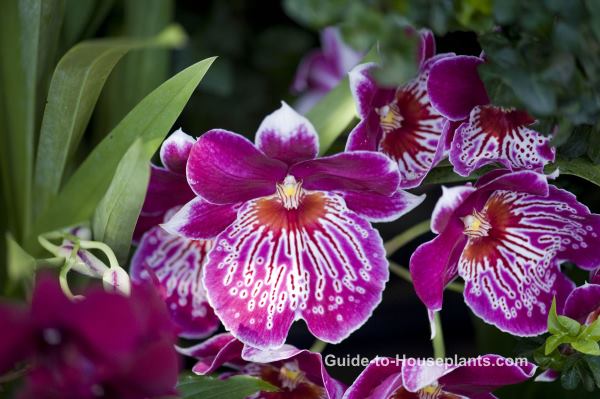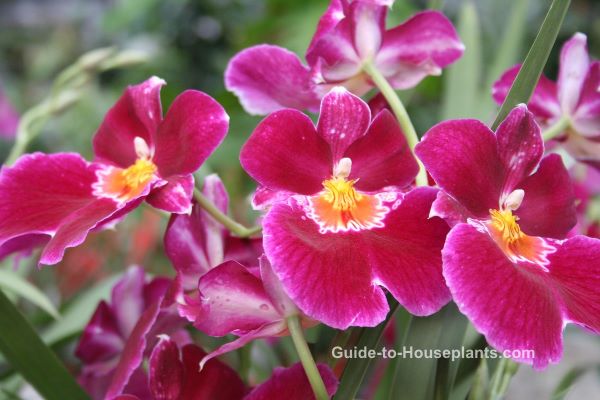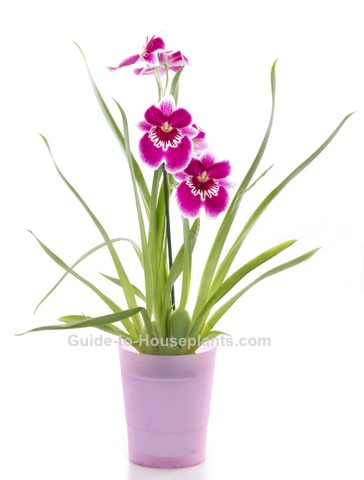Pansy Orchid Care
Botanical Name: Miltoniopsis orchid species
Miltoniopsis is commonly known as pansy orchid because it carries a striking resemblance to those popular garden flowers.

Get to Know Pansy Orchid
Their velvety, rounded petals are flat-faced, in colors ranging from white to pink to red, often with contrasting waterfall lines radiating outward from the center of the flower.
These charming flowers are fragrant and last about 4-5 weeks.
You can expect these evergreen orchids to bloom prolifically year after year. Most will bloom in spring, with some giving a second show of blooms in fall.
Miltoniopsis orchid has pseudobulbs, with 1 tall leaf growing from each tip. Tall flower stems carry as many as 10 pansy-like flowers, each growing up to 4 in (10 cm) wide.
Pansy orchids are epiphytes in the wild, growing on trees where they anchor themselves with thick roots. They like free-flowing air as in their native tropical habitats. Put your orchids where they'll enjoy plenty of air circulation, but away from heat or AC vents.
Pansy Orchid Problems, Solutions and Answers
To repot...or not. Fir bark medium breaks down after a couple years and needs replaced. The best time to repot is in summer, shortly after blooming. Don't over-pot, though. Miltoniopsis blooms best when slightly pot-bound.
Deadhead spent blooms. Each flower lasts about a month, then it'll look wilted. Cut off spent flowers right away.

Without question, Miltoniopsis loves humidity. If relative humidity drops below 60%, use a humidity tray or room humidifier to increase the moisture in the air. Grouping plants also helps to maintain the humidity around them.
Something bugging your orchid? Watch for thrips, that may invade houseplants. They're tiny and difficult to spot. You may first notice the silvery stippling and mottling of leaves, stems and flowers they cause by feeding on plant tissue. Thrips are attracted to hot, dry conditions -- another reason to keep the humidity high around your orchids. Treat an infestation immediately with an insecticide.
Got a reluctant bloomer? Give your orchid slightly cooler nighttime temperatures to spark blooming. A 15° difference will do. Pansy orchid will tolerate varying temperatures from 60° nights up to 85° days. They usually flower in spring, with some giving a second show of blooms in late summer or fall.
Pansy Orchid Care Tips

Origin: Central and South America
Height: 1-2 ft (30-60 cm)
Light: Put your orchids where they'll get plenty of bright light, but out of hot, direct sunlight during the summer months. If you don't have a spot near a window, fluorescent light works beautifully. Use 1 warm white tube and 1 cool white tube under a reflector. Place orchids about 8 inches (20 cm) beneath the light for 14-16 hours a day. It's also important to give them darkness at night. Orchids need a rest, too.
Water: Water thoroughly and allow the top inch of soil to dry out between waterings. These orchids store water in their rhizomes, and some species have water-storing pseudobulbs, making them more tolerant of dry soil than wet.
Humidity: This tropical native loves moist air, preferably at least 60% relative humidity. Indoor air can become extremely dry during the winter months; it's a good idea to use a humidity gauge, rather than guess. Although orchids may tolerate drier air, it's best to give them the high humidity they crave with a humidity tray or a cool-mist room humidifier.
Temperature: Will tolerate temperatures between 60-85°F/16-29°C.
Soil: Orchid potting mix is made up of a chunky bark mix that allows fast drainage, which is what pansy orchids need.
Fertilizer: Feed every 2 weeks with an orchid fertilizer in spring and summer, while plant is growing and flowering.
Propagation: Division. Divide the rhizome in summer, leaving each section with at least 2 pseudobulbs attached to each piece. Using a sharp knife, cut through the rhizome that joins them. Pot them separately.


